presented by
Loida Samsin *
I. Introduction
The Philippines is an archipelago which has numerous sites suitable for oyster farming. The cultivation of oysters in the country started in Bacoor Bay in Bacoor and Kawit towns in the province of Cavite. Operations were generally small-farm and family business. The average size of farm is 0.5 ha to 5 ha and the average production approximately 50 metric tons per hectare. Due to the proximity of these two towns to Metro Manila markets and the availability of land and water transportation facilities, marketing of oysters has not been a great problem. Moreover, the present demand for oysters still exceeds supply.
II. Species Cultured
There are four species of oysters cultivated: Crassostrea iredalei, C. cucullata, C. malabonensis and C. palmipes. Of these four species, C. iredalei is the most commercially desirable because it grows at a faster rate to a larger size and has straight shell margins which make them easier to open.
* Fisheries Officer, Bureau of Fisheries, Binakayan Research Laboratory, Cavite.
III. Farming Methods
Two methods of oyster cultivation are practised in Bacoor Bay: stake and hanging method. These are both productive and inexpensive and are widely used by the farmers.
Stake method - the basal portions of mature bamboos are used. The length of bamboo trunks depends upon the water depth at the farm site. They are arranged at 1.0 m interval. The tips of the stakes usually extend above the low water mark by about one-half meter (Plate 1).
Hanging method - the cultches installed in the oyster
plots consists of oyster shells strung in polyethylene
ropes of a certain length depending upon the height of
the water column where they are to be installed.
Holes are punched at the centre of the oyster shells by
means of a nail. The holes are just big enough for the
polyethylene rope to pass through. The oyster shells
are spaced at intervals of 12 cm by means of knots made
on the line (Fig. 1, Plate 2).
With regard to the construction and design of a
platform for the installation of the hanging collectors
different sizes of bamboos are used (Fig. 2) (42 pcs of
bamboo trunks, 21 pcs of cross poles, 10 pcs of
horizontal support poles and 1 kg of nails). The size
of each plot is usually 1 m × 20 m. Bamboo trunks are
staked at the bottom at one meter interval. A similar
series of bamboo trunks is positioned parallel to the
first. A meter-long piece of bamboo is nailed at each
to connect every pair of bamboo trunks. On top of
these cross pieces, three full length bamboos are
nailed horizontally, one row along each side and one in
the centre running parallel to each other (Plate 3).
The collectors are fixed on the oyster plots by tying
the free end of the polyethylene rope around the top
horizontal bamboo poles. The distance between
collectors is about 25–30 cm.
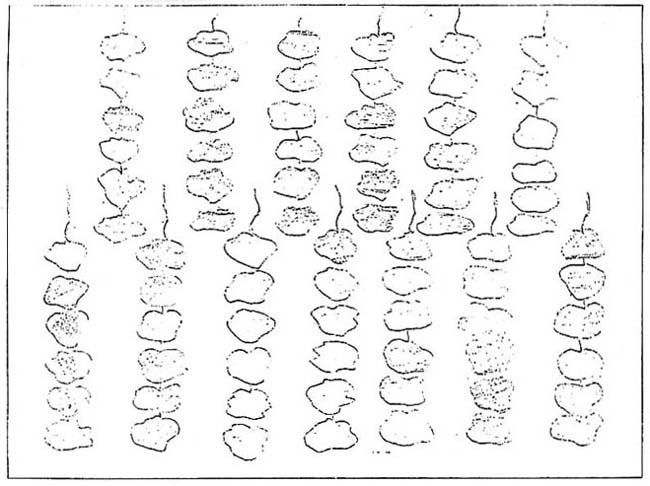
Figure 1. Oyster cultches.
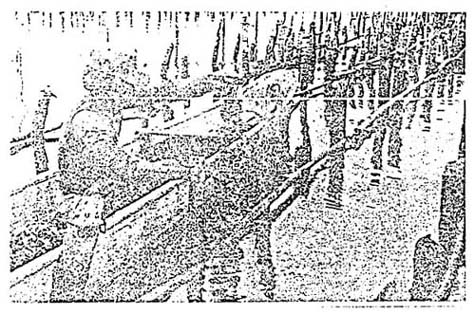
Plate 1. Oyster stake culture.
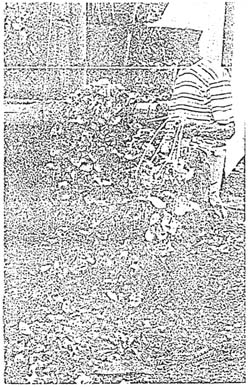
Plate 2. Oyster cultches.
IV. Management Practices
Stakes and collectors are installed in the natural oyster
spawning grounds during the months of May to August when the
environmental factors such as salinity and temperature are most
favorable. These months represent the peak period of oyster
spawning in the Philippines.
Predators like crabs, sea urchins, oyster drills are picked up by
hand. Sponges, annelids and barnacles are scraped off with the
aid of sharp knives. These fouling organisms tend to reduce the
yield by crowding or smothering newly settled spats as well as
slowing down the movement of water and transport of food.
Likewise, these organisms add weight to the collectors which can
cause the stakes to fall.
The farms are guarded vigilantly against poachers especially when
oysters have reached marketable size. Culture period is 6–8
months.
Oysters are best gathered during the months of March, April and
May. During this period they are fat, full, rounded, bulging and
creamy.
During harvesting divers swim underwater and pry off the clusters
of oysters from the stake with a mallet or any hard object and
put them in bamboo baskets placed at the centre of an inflated
rubber interior. When the basket is filled, the divers swim back
to the banca (boat) to unload the oysters after washing and
shaking them vigorously in sea water. Harvesting is much easier
with the hanging method (Plate 4). The hanging collectors are
simply cut off and hauled in the banca. The banca is brought
ashore or to the caretaker's house. The attached oysters are
removed from the shell collectors with sharp instruments.
Oysters are sorted according to size in order to separate the
marketable size from the undersized. The young and immature
oysters are returned to the bay either by broadcasting or
spreading them over the bottom or by putting them in bamboo trays
suspended from bamboo framework.
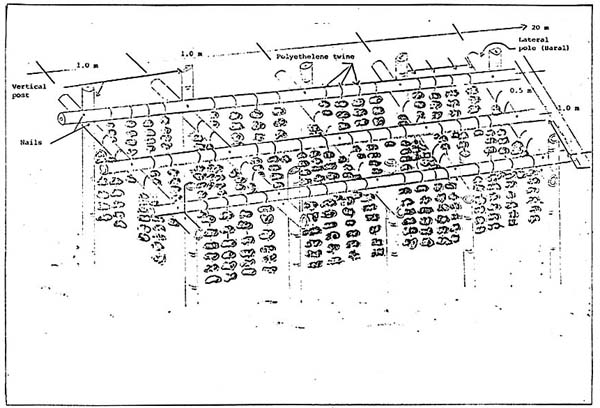
Figure 2. Oyster hanging platform.

Plate 3. Oyster platform.
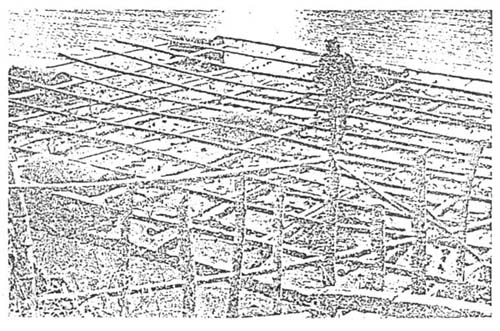
Plate 4. Oyster raft culture.
V. Marketing
Oysters are sold shell-on or shucked. Shucking is done with a
sharp knife. The meat is removed from the shells and placed in a
container filled with clean water. The meat is weighed and
measured by volume. Unshucked oysters are sold by the basket or
by the kilogram.
The present supply of oysters hardly meets local demand. Many
farm operators are hesitant to enter into contracts with
businessmen from other countries because they are afraid they may
not be able to meet the required quantity stipulated in the
contract.
Although oysters can be bought in the local market the whole year
round, demand is higher during certain months, usually during
summer when oysters are prepared for outings and other
gatherings. On the other hand, during stormy weather, the supply
is relatively low due to difficulty in harvesting.
VI. Problems
One major problem of oyster farming is the rapid siltation and pollution of the bays and estuaries. The bamboo poles used in oyster farming accelerate the deterioration of the environment by acting as barriers to the free flow of silt.